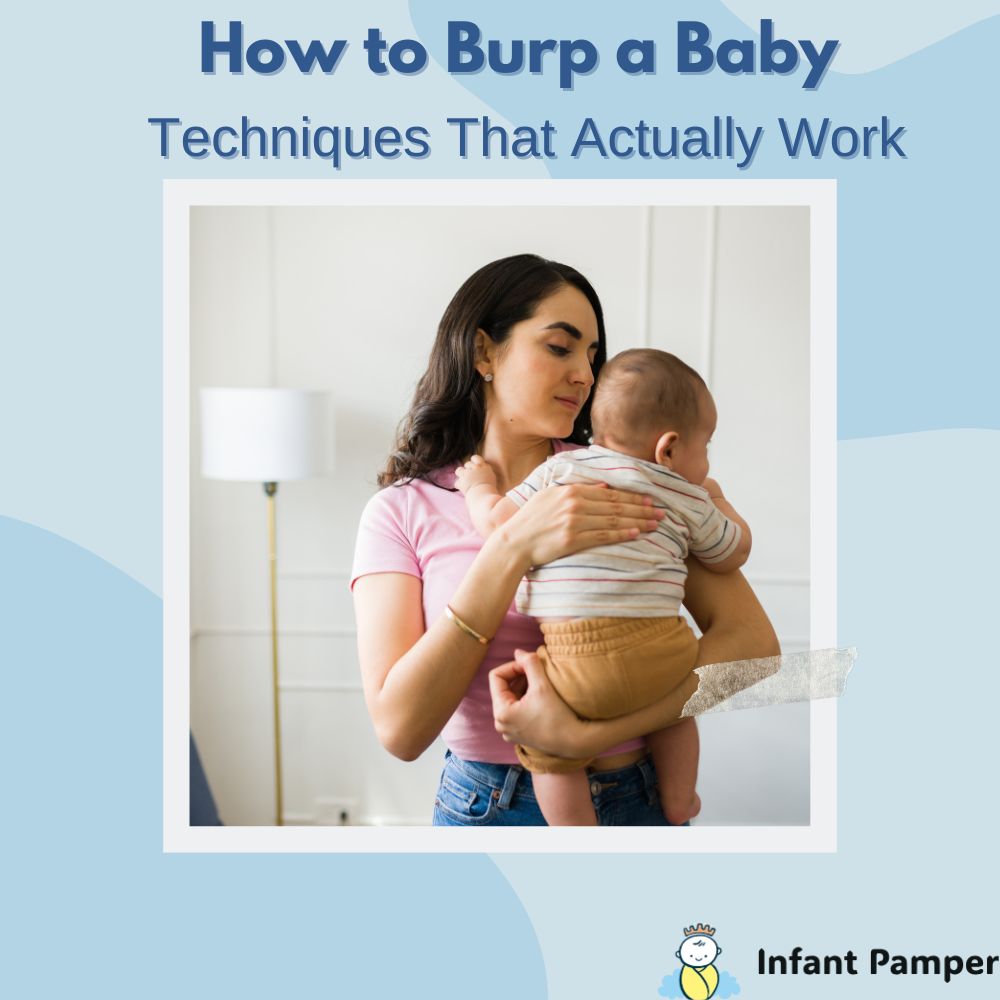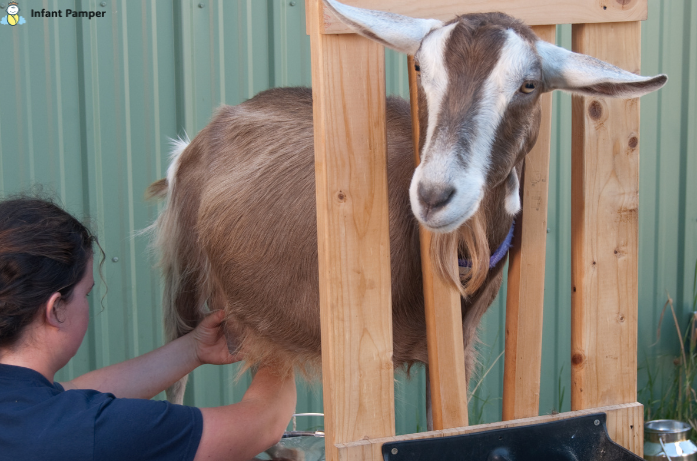By the infant pamper Team
If you’re a new parent, you’ve probably noticed that those adorable hiccups, squirmy legs, or sudden cries often come right after feeding. More often than not, the culprit is trapped air. Burping your baby might seem like a tiny task, but it can make a huge difference in their comfort, and your peace of mind.
But here’s the thing: while burping looks simple, many parents will tell you it sometimes feels like solving a mystery. One day your baby burps right away; the next day, nothing works. Some fall asleep mid-feed, making it trickier. Don’t worry, you’re not alone. Every baby is different, and learning how to burp a baby is part of the parenting journey.
At Infant Pamper, we’ve created this complete guide to walk you through why babies need to be burped, how often you should do it, and the best burping techniques for newborns that actually work.
Why Do Babies Need to Be Burped?
When babies feed, whether from breast or bottle, they often swallow air along with milk. This swallowed air gets trapped in their tiny tummies, creating pressure and discomfort. For newborns whose digestive systems are still developing, this can lead to fussiness, spit-up, or gassiness.
According to the American Academy of Pediatrics (AAP), burping during and after feeding helps reduce gas and can prevent reflux in infants. Similarly, the Mayo Clinic explains that gentle burping is a simple way to support newborn digestion.
Burping is simply helping your baby release that trapped air so they feel more comfortable. It can also:
- Reduce fussiness and crying after feeds
- Minimize spit-up episodes
- Prevent colic-like symptoms
- Help your baby feed better and more calmly
Think of burping as part of your baby’s natural feeding routine, just as important as latching, bottle positioning, or other infant care routines recommended by the CDC and NHS. Guidance from UNICEF also reassures parents that burping is a simple but essential way to keep babies comfortable after feeding.
How Often Should You Burp a Baby?
Here’s the good news: there’s no strict rulebook. Every baby is unique, but a few general guidelines help:
- During feeding: Burp after every 2–3 ounces if bottle-feeding, or when switching breasts if nursing.
- After feeding: Always try to burp right after a feed before laying your baby down.
- When signs show: If your baby looks uncomfortable, squirmy, or pulls away mid-feed, take a quick break to burp.
Some babies need frequent burping, while others are content with one quick release. It all depends on their feeding style, how much air they swallow, and their little personalities.

Most Effective Burping Techniques
Here are three tried-and-true methods parents swear by. Experiment to see which one works best for your baby:
1. Over-the-Shoulder Burping Method
This is a classic. Hold your baby upright against your chest, resting their chin on your shoulder. Support their bottom with one hand while gently patting or rubbing their back with the other. Don’t forget a burp cloth, spit-ups love to surprise!
2. Sitting on Your Lap
Place your baby in a sitting position on your lap, facing sideways or forward. Support their chest and chin with one hand (never pressing the throat), while the other hand gently pats their back. This upright method is especially good for babies who dislike lying down after feeds, and it’s recommended in many pediatrician visit consultations. According to, KidsHealth supporting your baby’s chest while gently patting their back is one of the safest and most effective ways to burp.
3. Lying Face Down on Your Lap
Lay your baby tummy-down across your lap, with their head slightly raised and turned to the side. Supporting their head, gently pat or rub their back. Many parents find this is one of the most gentle ways to burp a newborn, as the tummy pressure can feel soothing, similar to how tummy time helps strengthen muscles.
👉 Parent Tip: Use a soft, rhythmic pat or slow circular rub instead of firm thumps. Babies respond more to gentle consistency than force.
Extra Tips to Make Burping Easier
- Stay calm and relaxed. Babies sense tension, so breathe and take your time.
- Switch techniques. If one method doesn’t work, try another after a few minutes.
- Time it right. Don’t wait too long, burping works best when babies are still semi-upright.
- Use upright time. Hold your baby upright for 10–15 minutes after feeding to reduce spit-up.
- Protect clothes. A baby bib or burp cloth is your best friend.
Remember: not all babies burp every single time. That’s completely normal.
Common Myths About Burping
- “Every baby must burp after every feed.” Not true, follow your baby’s cues.
- “Patting harder works faster.” Actually, gentleness is more effective.
- “If they don’t burp, something’s wrong.” Many healthy babies don’t always need to burp.
When to Call the Doctor
Trust your instincts. Burping is usually simple, but there are times you should check in with a pediatrician:
- Your baby spits up forcefully or vomits often
- They show poor weight gain
- They seem in pain after nearly every feed
- Fussiness and crying don’t improve with burping
If you’re ever unsure, reach out to your doctor. Sometimes little adjustments in bottle-feeding techniques (like using anti-colic bottles) or breastfeeding positions can make all the difference.
A Gentle Routine That Builds Connection
Burping isn’t just about relieving gas, it’s a parent-infant bonding moment. You’re holding your baby close, patting their back, whispering, or humming. These small acts create trust, rhythm, and comfort.
Whether you get a loud, satisfying burp or none at all, the effort itself strengthens your connection with your baby. And that’s what really matters.
Frequently Asked Questions (FAQ)
Q1. At what age do babies stop needing to be burped?
Most babies need burping regularly until about 4–6 months old, when their digestive systems mature. After that, many can release gas on their own.
Q2. Do breastfed babies need burping as much as bottle-fed babies?
Not always. Breastfed babies usually swallow less air than bottle-fed babies, but many still need occasional burping, especially newborns.
Q3. Can burping help with colic?
It may help reduce discomfort, but colic usually involves more than just trapped air. If your baby cries for hours daily, consult your pediatrician.
Q4. What if my baby falls asleep before I burp them?
You can still try gentle burping while they’re asleep, many babies burp without fully waking up. If they seem comfortable, it’s okay to let them rest.
Q5. Is spit-up the same as vomiting?
No. Spit-up is usually small and effortless. Vomiting is more forceful and may indicate a medical issue.
Final Thoughts & Gentle Reminder
Burping your baby is less about following strict rules and more about paying attention to their unique cues. Some babies are easy burpers; others take patience. And sometimes, no burp is totally fine.
Remember: Every baby is different. Stay calm, keep trying different techniques, and most importantly, trust your instincts.
Disclaimer: This article is for informational purposes only and not a substitute for medical advice. Always consult your pediatrician if you have concerns about your baby’s feeding, health, or development.
At Infant Pamper, we’re here to guide you through every stage of your baby’s growth, from burps to first steps.
👉 If you found this guide helpful, share it with another new parent who might be feeling overwhelmed. And don’t forget to check out our other parenting tips designed to make early parenthood a little easier, and a lot more joyful.




